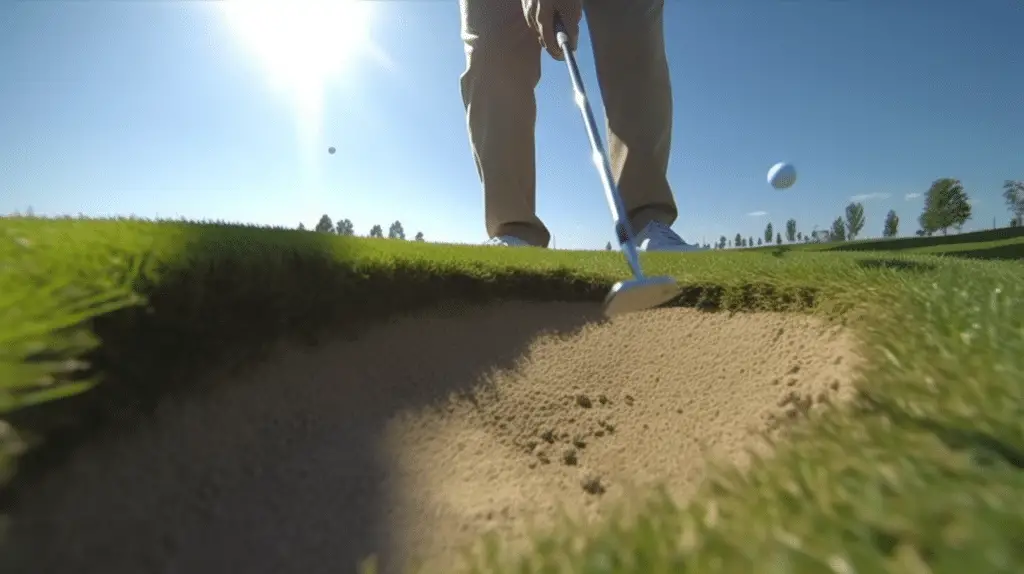Last Updated on June 9, 2023
Taking a divot in golf is an essential skill for any golfer hoping to improve their game. Knowing how and when to take the right divot can drastically reduce scores, making it necessary for players of all levels to understand the basics of taking a proper divot.
So, what exactly is a divot? This article will provide some tips on how to take a divot in golf to maximise performance on the course.
Benefits of Taking a Divot
The term “divot” refers to the piece of turf that is displaced when striking with a club. If taken correctly, this small chunk of grass can help impart spin and control onto the ball, giving golfers more accuracy with each stroke. Taking a divot is an important technique for improving one’s golf game. It not only helps to improve the accuracy and trajectory of a shot but also provides several other benefits. Understanding how to take a divot can help players in their pursuit of greater success on the course.
When taking a divot, it is important that golfers ensure they are doing so correctly. This will result in improved ball striking, which leads to better control over shots and increased distance off the tee due to more powerful swings. Additionally, understanding the proper divot technique prevents turf damage from occurring during play by reducing excess force when hitting the ground with one’s club head. Taking a divot with precision can even offer assistance in controlling spin rate on short iron shots and wedges around greens, allowing players to be more accurate with their approach shots.
Pre-Swing Stance and Grip
When preparing to take a divot in golf, it is important for the golfer to have a good pre-swing stance and grip technique. Achieving optimal posture for the swing requires the following certain steps:
- Stand with your feet shoulder-width apart
- Bend at the knees until you are comfortably crouched
- Place hands on the club handle so that palms face one another

Having proper posture will allow the golfer to make an efficient backswing. To ensure correct hand placement, start by gripping the club firmly but not overly tight and place your thumbs in line along the shaft of the club. The left hand should be slightly lower than the right when holding the driver or fairway woods, while both hands should be equal height when hitting irons. When preparing to take a divot, focus on aligning the body correctly and ensuring the arms are parallel with the chest throughout the swing motion. Additionally, check that the ball position is centred between players’ feet prior to taking a shot. This establishes balance which encourages a smooth transition from address through follow-through without interruption. With these elements in mind, golfers can refine their pre-swing stance and grip technique for the successful execution of a divot.
Backswing Mechanics
The backswing is the next step in executing a golf shot. It must be executed with care and precision to ensure consistent contact between clubhead and ball. Properly mastering divot mechanics is essential for creating an effective backswing technique and ultimately improving overall performance on the course.
| Divot Mechanics | Backswing Technique |
|---|---|
| Maintain good posture | Smooth shoulder turn |
| Rotate upper torso around the spine | Weight shift from feet to hips |
| Shoulders parallel to the target line | Left arm should remain straight as much as possible |
| Relaxed grip pressure | Rotate the upper torso around the spine |
Different elements of divot mechanics are important depending on what type of shot is being played, such as a full swing or pitch shot. For a full swing, it’s important that the arms stay straight while maintaining good posture during the take away the portion of the backswing. The shoulders will rotate inwards towards their original position at address throughout the entire length of the backswing until they reach parallel with the target line. This helps create power through weight shifting from your feet up into your hips before releasing onto impact. While keeping your arms straight but relaxed, rotate your upper torso around your spine, allowing your left arm to remain almost fully extended throughout the entire motion. Doing so allows for increased control over direction and distance when hitting shots. Utilising these techniques can help develop consistency within one’s golf game which leads to improved results on the course.
Common Mistakes When Taking a Divot
Taking a divot is an important part of the golf swing, but it can also be one of the most difficult steps to master. One common mistake when taking a divot is over-hitting or hitting too hard, which causes the club to dig into the ground and take out a large chunk of turf. This type of deep divot often results in uneven shots and affects ball trajectory. Another mistake that occurs when taking a divot is making a shallow cut into the grass due to not enough force from the clubface at impact. Shallow divots are especially problematic because they cause less backspin on shots, resulting in more skidding off course upon landing. Lastly, the improper angle may occur while taking a divot if the golfer’s body position shifts during their downswing. If this happens, then there will most likely be inconsistent contact with the surface leading to miss-hits and poor performance overall. It is essential for any golfer striving for accuracy and consistency in their game to learn how to properly take a clean, consistent divot with each shot.
Conclusion
In conclusion, knowing how to properly take a divot in golf is essential not only for full swing shots but also various other types of strokes like chipping or pitching around the green. It is advisable that one practice frequently in order to gain confidence prior to implementing on the course; this includes ensuring correct foot placement along with arm extension and keeping grip pressure firm yet relaxed throughout the motion. Once mastered, utilising this technique can help enhance overall performance during any round of golf.



